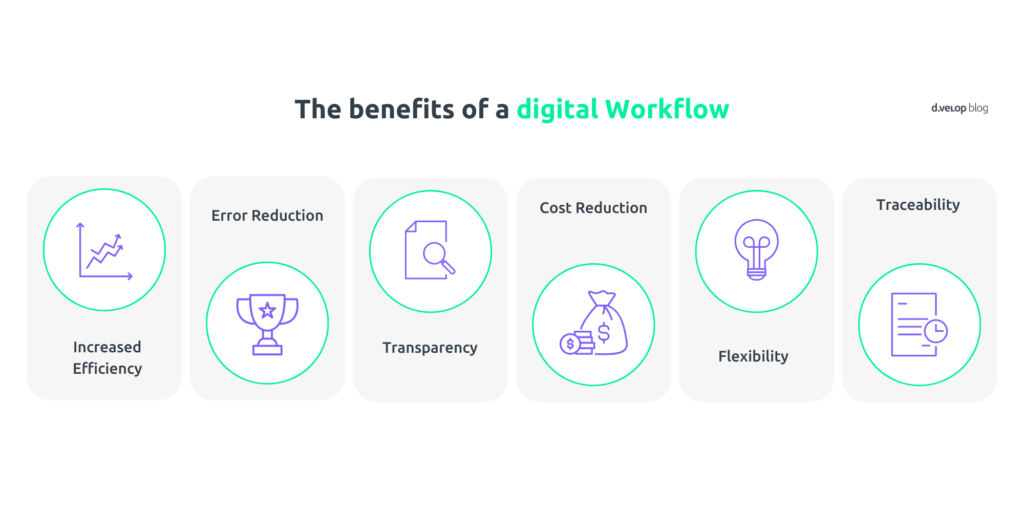Unquestionably, integrated digital transformation drives business success. Mckinsey & Co state that when businesses embrace digital integration, such as integrating DMS with SAP, they establish a stronger foundation for innovation. Furthermore, they are more readily able to adapt to market changes, respond to customer needs faster, resulting in enhanced customer satisfaction and retention rates.
For businesses using SAP as their core ERP solution, the benefits of aligning DMS with SAP go far beyond simple file storage; it supports end-to-end document handling, boosts operational efficiency, and enhances compliance. Integrating DMS with SAP provides a robust framework for these benefits.
Let’s take a closer look at the major benefits of integrating DMS with SAP
1. Streamlined Workflows and Increased Productivity
With integration, documents created or managed in SAP—such as invoices, purchase orders, or contracts—are instantly available within your DMS, reducing the need for duplicative data entry and document handling. Employees can retrieve, share, and edit documents in real-time directly via the SAP interface, saving time and eliminating the chance of errors, thereby facilitating the process of integrating DMS with SAP.
Streamlined workflows ensure that critical documents are available where they need to be, when they need to be, boosting team productivity and speeding up decision-making. According to PWC, strategic integration offers typically an increase in productivity of 30-40% through streamlined workflows and improved collaboration.
2. Enhanced Data Accuracy and Reduced Redundancies
Duplicating data across systems can create a source of errors, especially when document information needs to be re-entered manually. Integrating DMS with SAP ensures data synchronisation, meaning document versions are automatically updated across both platforms, reducing the risk of mismatched information. This single “source of truth” ensures quality and compliance, allowing teams to work confidently in the knowledge they are using the correct version of document.
3. Improved Compliance and Data Security
Document-heavy industries, such as finance, healthcare, and manufacturing, must adhere to stringent compliance standards and data protection regulations. With a DMS integrated into SAP, businesses can establish central governance for document storage, access permissions, and audit trails. This integration allows for precise control over sensitive documents, ensuring that only authorised personnel have access. Additionally, integration helps businesses easily meet data retention requirements and supports a robust audit trail, essential for regulatory compliance.
4. Accelerated Approval Processes
The integration of DMS with SAP can significantly streamline approval workflows. For example, purchase orders and invoices can automatically trigger approval requests that flow seamlessly through both systems. Automated notifications alert the right personnel, who can then review and approve documents directly within SAP. This not only speeds up the process but also eliminates bottlenecks, making financial reporting more transparent and efficient.
5. Cost Savings Through Optimised Resource Utilisation
By automating document handling processes and reducing the need for paper-based workflows, integrating DMS with SAP becomes a critical factor in reducing operational costs. Introducing cloud-based solutions, can result in 30-40 % IT cost reductions. The time saved by employees who no longer need to search for or manually file documents can be reallocated to higher-value tasks. Additionally, it reduces storage and printing costs, as fewer physical documents are required. This leaner, more digital approach helps companies cut costs, whilst improving resource utilisation.
6. Easier Document Retrieval and Improved Customer Service
With DMS and SAP integration, all customer-related documents can be accessed directly from within SAP, giving customer service representatives instant access to information like order histories, shipping documents, or billing information. This ability to retrieve documents on demand, ensures that customer inquiries are resolved quickly and accurately, leading to higher customer satisfaction.
7. Seamless Collaboration Across Departments
In any business, documents often flow across multiple departments—finance, HR, logistics, and more. With DMS integration, SAP becomes the single hub for document access, promoting seamless collaboration across teams. For instance, the finance team can check delivery notes or contracts related to invoices without leaving SAP, ensuring all departments have access to the necessary context and documents without time consuming back-and-forth emails or calls.
8. Supports Scalability and Future Growth
As businesses grow, so does the volume of data they handle. An integrated DMS-SAP system can scale effortlessly, supporting increased document volumes without compromising speed or performance. Integration ensures that as your SAP environment expands, your document management processes grow with it, supporting your business’s evolution and positioning you for future success.
A guide to automated procure-to-pay processes in SAP
Final Thoughts
Integrating a Document Management System with SAP offers numerous benefits, from enhanced productivity and compliance to cost savings and improved customer service. This unified approach to document handling turns SAP into a powerful information hub, supporting efficient workflows and aligning with business goals. For companies ready to embrace digital transformation, a DMS-SAP integration represents an opportunity to not only enhance their current processes but also future-proof their operations in an increasingly data-driven world.
In short, if your business relies on SAP, an intelligently integrated DMS could be the missing link that propels your organisation forward. Achieving greater agility, far more resilient and most importantly, enabling your business to establish a competitive edge in a fast-paced digital landscape.
These templates are ready to use. You can implement them individually, sequentially, or in combination:

